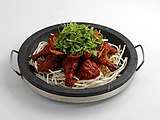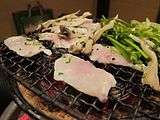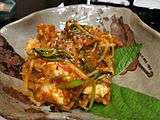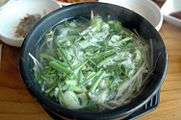Fugu
The fugu (河豚; 鰒; フグ) in Japanese, bogeo (복어) or bok (복) in Korean, and hétún (河豚; 河鲀) in Standard Modern Chinese[1] is a pufferfish, normally of the genus Takifugu, Lagocephalus, or Sphoeroides, or a porcupinefish of the genus Diodon, or a dish prepared from these fish.
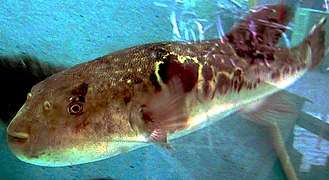
Fugu can be lethally poisonous due to its tetrodotoxin, meaning it must be carefully prepared to remove toxic parts and to avoid contaminating the meat.[2]
The restaurant preparation of fugu is strictly controlled by law in Japan and several other countries, and only chefs who have qualified after three or more years of rigorous training are allowed to prepare the fish.[2][3] Domestic preparation occasionally leads to accidental death.[3]
Fugu is served as sashimi and chirinabe.[3] Some consider the liver to be the tastiest part, but it is also the most poisonous, and serving this organ in restaurants was banned in Japan in 1984.[3] Fugu has become one of the most celebrated and notorious dishes in Japanese cuisine.
Toxicity
Fugu contains lethal amounts of the poison tetrodotoxin in its inner organs, especially the liver, the ovaries, eyes, and skin.[4] The poison, a sodium channel blocker,[5] paralyzes the muscles while the victim stays fully conscious;[6] the poisoned victim is unable to breathe, and eventually dies from asphyxiation.[7] There is no known antidote for fugu poison.[8] The standard treatment is to support the respiratory and circulatory systems until the poison is metabolized and excreted by the victim's body.[9]
Researchers have determined that a fugu's tetrodotoxin comes from eating other animals infested with tetrodotoxin-laden bacteria, to which the fish develops insensitivity over time.[10] As such, efforts have been made in research and aquaculture to allow farmers to produce safe fugu. Farmers now produce 'poison-free' fugu by keeping the fish away from the bacteria; Usuki, a town in Ōita Prefecture, has become known for selling non-poisonous fugu.[10]
Consumption
History
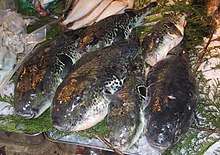
The inhabitants of Japan have eaten fugu for centuries. Fugu bones have been found in several shell middens, called kaizuka, from the Jōmon period that date back more than 2,300 years. The Tokugawa shogunate (1603–1868) prohibited the consumption of fugu in Edo and its area of influence. It became common again as the power of the Shōgunate weakened. In western regions of Japan, where the government's influence was weaker and fugu was easier to get, various cooking methods were developed to safely eat them. During the Meiji Era (1867–1912), fugu was again banned in many areas.[11] Fugu is the only food the Emperor of Japan is forbidden by law to eat, for his safety.[12]
In China, the use of the pufferfish for culinary purposes was already well established by the Song dynasty as one of the 'three delicacies of the Yangtze' (長江三鮮) and appears in the writings of the polymath Shen Kuo[13] as well as in the encyclopedic work Taiping Guangji.[14] The scholar-statesman Su Shi famously remarked that the taste is worthy of death (值那一死).[15]
Species
The torafugu, or tiger pufferfish (Takifugu rubripes), is the most prestigious edible species and the most poisonous. Other species are also eaten; for example, Higanfugu (T. pardalis), Shōsaifugu (T. vermicularis syn. snyderi), and Mafugu (T. porphyreus). The Ministry of Health, Labour and Welfare of Japan provides a list[16] that shows which species' body parts can be consumed. The list names safe genera including pufferfish of the Lagocephalus and Sphoeroides genera and the related porcupinefish (Harisenbon) of the family Diodontidae.
Regulations
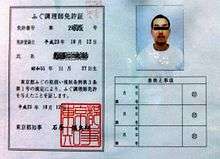
Strict fishing regulations are now in place to protect fugu populations from depletion. Most fugu is now harvested in the spring during the spawning season and then farmed in floating cages in the Pacific Ocean. The largest wholesale fugu market in Japan is in Shimonoseki.
Fugu prices rise in autumn and peak in winter, the best season, because they fatten to survive the cold. Live fish arrive at a restaurant, surviving in a large tank, usually prominently displayed. Prepared fugu is also often available in grocery stores, which must display official license documents. Whole fish may not be sold to the general public.
Since 1958, fugu chefs must earn a license to prepare and sell fugu to the public. This involves a two- or three-year apprenticeship. The licensing examination process consists of a written test, a fish-identification test, and a practical test, preparing and eating the fish. Only about 35 percent of the applicants pass.[17] Small miscalculations result in failure or, in rare cases, death. Consumers believe that this training process makes it safer to eat fugu in restaurants or markets.[18] Also, commercially available fugu is sometimes grown in environments in which it grows to be less toxic.
Since October 2012, restaurants in Japan have been permitted to sell fugu which has been prepared and packaged by a licensed practitioner elsewhere.[19]
Cost
In case of Torafugu, the most common fugu, it costs between ¥1000 and ¥5000 per 1kg, while depending on the season.[20] The expense encourages chefs to slice the fish very carefully to obtain the largest possible amount of meat. The special knife, called fugu hiki, is usually stored separately from other knives.
Toxin
Tetrodotoxin (TTX) is a natural product that has, as of 2015, been isolated from puffer fish, but also from octopuses, from crabs and shellfish, from frogs and newts, as well as other aquatic animals (see below).[21] It is a potent neurotoxin that shuts down electrical signaling in nerves; it acts via interaction with components of the sodium channels in the cell membranes of those cells.[21] It does not cross the blood–brain barrier. In the case of the pufferfish host, at least (see below), their insusceptibility to the poison results from a mutation in their sequence of their specific types of sodium channel proteins.
TTX is not produced by puffer fish and the other aquatic animals from which it has been isolated; rather, bacteria such as Alteromonas, Shewanella, and Vibrio species infect or cohabit with the animal species from which TTX is isolated, and a bacterial biosynthetic pathway for its production has been rationalized.[21][22][23]
In animal studies with mice, the median lethal dose of TTX was found to be 232 µg per kg body weight.[24] Tetrodotoxin levels are affected by preparation (removal of most toxic materials, treatments such as curing and pickling, see below); it is, however, reportedly not significantly affected by cooking.[25]
Treatment
The symptoms from ingesting a lethal dose of tetrodotoxin may include dizziness, exhaustion, headache, nausea, or difficulty breathing. The person remains conscious but cannot speak or move. Breathing stops and asphyxiation follows.
There is no known antidote, and treatment consists of emptying the stomach, giving the person activated charcoal to bind the toxin, and putting them on life support until the poison has worn off. Toxicologists have been working on developing an antidote for tetrodotoxin.
Incidents
Statistics from the Tokyo Bureau of Social Welfare and Public Health indicate 20 to 44 incidents, some affecting multiple diners, of fugu poisoning per year between 1996 and 2006 in Japan. Between 34 and 64 people were hospitalized, and zero to six died, per year, with an average fatality rate of 6.8%.[26] Of the 23 incidents reported in Tokyo from 1993 through 2006, only one took place in a restaurant; all others involved people catching and eating the fish.[26] Poisonings through amateur preparation can result from confusion between types of puffer, as well as improper methods, and some may represent deliberate suicide attempts. Engelbert Kaempfer, a German physician who resided in Japan in the 1690s, reported that an unusually toxic variety of puffer was sometimes sought out by individuals who wished to take their own lives.[27]
Much higher figures were reported in earlier years, peaking in 1958 when 176 people died from eating fugu in a single year.[17] According to the Fugu Research Institute, 50% of the victims were poisoned by eating the liver, 43% from eating the ovaries, and 7% from eating the skin. One of the most famous victims was the Kabuki actor and "Living National Treasure" Bandō Mitsugorō VIII, who in 1975 died after eating four servings of fugu kimo (fugu liver),[23] the sale of which was prohibited by local ordinances at the time.[28] Bandō claimed to be able to resist the poison,[23] but died several hours after returning to his hotel.[28]
On August 23, 2007, a doctor in Thailand reported that unscrupulous fish sellers sold puffer meat disguised as salmon, which caused fifteen deaths over three years. About 115 people were taken to different hospitals. Fugu had been banned in Thailand five years prior to the deaths.[29]
In March 2008, a fisherman in the Philippines died and members of his family became ill from pufferfish. The previous year, four people in the same town died and five others had fallen ill after eating the same variety of pufferfish.[30]
In February 2009, a Malaysian fisherman died and four others were hospitalised after they consumed a meal of puffer fish when they ran out of food while at sea.[31]
In November 2011, a chef at two-Michelin star "Fugu Fukuji" in Tokyo was suspended from his post. The chef served fugu liver to a customer who, despite being warned of the risks, specifically asked that it be provided. The 35-year-old customer subsequently required hospital treatment for mild symptoms of tetrodotoxin paralysis, but made a full recovery.[32]
Five men were poisoned at a restaurant in Wakayama in March 2015 after specifically asking for liver.[33][34][35]
Preparations
Japan
- Sashimi — The most popular dish is fugu sashimi, also called Fugu sashi or tessa. Knives with exceptionally thin blades are used for cutting fugu into translucent slices, a technique known as Usuzukuri (薄造, うすづくり).[36]
- Milt — The soft roe (Shirako) of the blowfish is a highly prized food item in Japan, and it is often found in department stores. Along with cod milt, it is one of the most popular kinds of soft roe, and it is often grilled and served with salt.
- Fried — Fugu can be eaten deep fried as Fugu Kara-age.
- Smoked — Fugu-fin sake. Sake infused with the smoked fin of the blowfish (fugu) to give a distinctive smoky, fishy flavour known as Hire-zake.[37]
- Stew — Vegetables and fugu can be simmered as Fugu-chiri, also called tetchiri, in which case the fish's very light taste is hard to distinguish from the vegetables and the dip.
- Salad — If the spikes in the skin are pulled out, the skin can be eaten as part of a salad called yubiki.
- Ovary — The ovary of the pufferfish contains greater amounts of the lethal poison tetrodotoxin than other parts of the body.
In the cuisine of Hakusan, Ishikawa, ovaries are served after effort is made to reduce the toxin level by salting and pickling for three years—e.g., in "Blowfish Ovaries Pickled in Rice-Bran Paste" (河豚の卵巣の糠漬け, ふぐのらんそうのぬかづけ).[38] Only the "Mikawa district of Hakusan City, the Ono and Kanaiwa districts of Kanazawa City, and Wajima City, all in Ishikawa Prefecture" are permitted to perform the process, and only by the traditional method, and explicit warnings are offered to dissuade non-professionals from attempting the 3-year process.[38][39] After one year of pickling—about a third of the way through the process—about 10% of the toxin is suggested to remain,[40] and after the full three years the product is "only sold after having been checked for safety through a toxicity inspection, and other tests."[39]
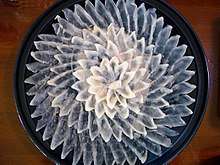 Plate of fugu sashimi
Plate of fugu sashimi- Fugu no Shirako
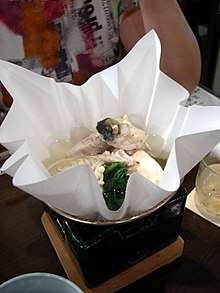 Fugu-nabe, pufferfish hotpot
Fugu-nabe, pufferfish hotpot- Fugu no ransou nukazuke, Blowfish Ovaries Pickled in Rice-Bran Paste
Korea
In Korean cuisine, edible pufferfish are prepared in various ways including gui (grilling), jorim (simmering), and guk (soup).
Availability
Most Japanese cities have one or more fugu restaurants, perhaps in clusters because of earlier restrictions, as proximity made it easier to ensure freshness. A famous restaurant specializing in fugu is Takefuku, in the Ginza district in Tokyo. Zuboraya is another popular chain in Osaka.
In South Korea, fugu is known as bok-eo (복어). It is very popular in port cities such as Busan and Incheon. It is prepared in a number of dishes such as soups and salads, and commands a high price.
The fugu is cleaned of the most toxic parts in Japan and freeze-flown to the United States under license in customized, clear, plastic containers. Fugu chefs for American restaurants are trained under the same rigorous specifications as in Japan. Pufferfish native to American waters, particularly the genus Spheroides, have also been consumed for food, sometimes resulting in poisonings.[41]
Sale of fish belonging to this genus is forbidden altogether in the European Union.[42]
Japanese restaurateur Nobuyoshi Kuraoka waged a five-year battle with the Food and Drug Administration to allow exclusive import of the Japanese Puffer Tiger fish to his restaurant in Manhattan, with the license granted in 1989.[43][44][45] By 2003 only seventeen restaurants in the United States were licensed to serve fugu; twelve of those were in New York City.[46]
Social aspects
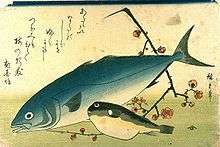
In the Kansai region, the slang word teppō, (鉄砲) meaning rifle or gun, is used for the fish. This is a play of words on the verb ataru (当たる), which can mean to be poisoned or shot. In Shimonoseki region, the ancient pronunciation fuku is more common instead of the modern fugu.[47] The former is also a homonym for good fortune whereas the latter is one for disabled. The Tsukiji fish market fugu association holds a service each year at the height of the fugu season, releasing hundreds of caught fugu into the Sumida River. A similar ceremony is also held at another large market in Shimonoseki.
A rakugo, or humorous short story, tells of three men who prepared a fugu stew but were unsure whether it was safe to eat. To test the stew, they gave some to a beggar. When it did not seem to do him any harm, they ate the stew. Later, they met the beggar again and were delighted to see that he was still in good health. After that encounter, the beggar, who had hidden the stew instead of eating it, knew that it was safe and he could eat it. The three men had been fooled by the wise beggar.
Lanterns can be made from the bodies of preserved fugu. These are occasionally seen outside of fugu restaurants, as children's toys, as folk art, or as souvenirs. Fugu skin is also made into everyday objects like wallets or waterproof boxes.
Aquaculture
Scientists at Nagasaki University have reportedly succeeded in creating a non-toxic variety of torafugu by restricting the fish's diet.[48] After raising over 4,800 non-toxic fish, they are fairly certain that the fish's diet and digestive process actually produce the toxins. The non-toxic version is said to taste the same. Some skeptics say that the fish being offered as non-toxic may be of a different species, and that the toxicity has nothing to do with the diet of the pufferfish.[49]
See also
- Culture of Japan
- Cuisine of Japan
- Culture of Korea
- Cuisine of Korea
- Fugu Plan
- List of delicacies
- Shanghai Fugu Agreement
- Takifugu
- "One Fish, Two Fish, Blowfish, Blue Fish"
- Sequencing of the Takifugu genome
References
- In Classical Chinese and the various regional varieties of Chinese, there are nearly a dozen synonyms that refer to the toxic pufferfish, including 䲅, 𩷪鱼, 黄驹, 魺, 嗔鱼, 鲑, 鲐鱼, 鮧, 鯸鲐, 鯸鮧, 鰗鮧, 鹕夷, 鯸䱌, and 䰽.
- Davidson A (2006). The Oxford Companion to Food. Oxford University Press. p. 324. ISBN 978-0-19-280681-9.
- Hosking R (1997). A Dictionary of Japanese Food: Ingredients & Culture. Tuttle Publishing. pp. 41–42. ISBN 978-0-8048-2042-4.
- Yong, Y. S.; Quek, L. S.; Lim, E. K.; Ngo, A. (2013). "Pufferfish poisoning case study". Case Reports in Medicine. 2013: 206971. doi:10.1155/2013/206971. PMC 3867830. PMID 24368916.
- Lee CH, Ruben PC (1 November 2008). "Interaction between voltage-gated sodium channels and the neurotoxin, tetrodotoxin". Channels. 2 (6): 407–12. doi:10.4161/chan.2.6.7429. PMID 19098433.
- Lago J, Rodríguez LP, Blanco L, Vieites JM, Cabado AG (October 2015). "Tetrodotoxin, an Extremely Potent Marine Neurotoxin: Distribution, Toxicity, Origin and Therapeutical Uses". Marine Drugs. 13 (10): 6384–406. doi:10.3390/md13106384. PMC 4626696. PMID 26492253.
- Cheng, K. K.; Ling, Y. L.; Wang, J. C. (April 1968). "The failure of respiration in death by tetrodotoxin posioning". Quarterly Journal of Experimental Physiology and Cognate Medical Sciences. 53 (2): 119–128. doi:10.1113/expphysiol.1968.sp001951. ISSN 0033-5541. PMID 5185564.
- Larimore JL (25 May 2017). Neuroscience Basics: A Guide to the Brain's Involvement in Everyday Activities. Elsevier Science. p. 57. ISBN 978-0-12-811017-1.
- "CDC - The Emergency Response Safety and Health Database: Biotoxin: TETRODOTOXIN - NIOSH". www.cdc.gov. 9 November 2017.
- Onishi N (2008-05-04). "If the Fish Liver Can't Kill, Is It Really a Delicacy?". The New York Times.
- Farnham A. "Killer Foods". Forbes. Retrieved 2009-05-20.
- Glionna JM. "Blowfish's bad rap is killing him". Los Angeles Times. Retrieved 2015-02-12.
- 《梦溪笔谈》:吳人嗜河豚魚,有遇毒者,往往殺人,可為深戒。
- 《太平廣記 》:鯸鮐魚文斑如虎,俗云煮之不熟,食者必死。
- 《河南邵氏聞見後錄》:經筵官會食資善堂,東坡盛稱河豚之美。呂元明問其味,曰:「直那一死!」
- "魚類:フグ毒 [Fugu poison]" (in Japanese). Ministry of Health, Labour and Welfare Japan.
- "One Man's Fugu Is Another's Poison". The New York Times. 1981-11-29. Retrieved 2010-05-03.
- Matsutani, Minoru, "Tokyo to drop fugu license ordinance amid a decline in fatal diner poisonings", Japan Times, 5 March 2012, p. 2. Archived March 7, 2012, at the Wayback Machine
- Ito, Shingo (Jiji Press), "Fugu's risk will always be part of its charm", Japan Times, 5 July 2012, p. 3 Archived July 8, 2012, at the Wayback Machine
- "Market Conditions of Torafugu in Toyosu Market (Monthly Report)" (in Japanese). GD Freak. Retrieved 2019-09-24.
- Sato K, Akai S, Yoshimura J (May 2015). "Stereocontrolled total synthesis of tetrodotoxin from myo-inositol and D-glucose by three routes: aspects for constructing complex multi-functionalized cyclitols with branched-chain structures". Natural Product Communications. 10 (5): 691–702. doi:10.1177/1934578X1501000501. PMID 26058138.
The original name of TTX was “taricatoxin” … TTX selectively interacts with elements of the sodium channel … TTX has been isolated from the puffer fish, newts, frogs, octopuses, crabs, shellfish, and numerous other aquatic animals. The animals do not produce TTX themselves; instead, it is produced by bacteria such as Alteromonas sp., Vibrio sp., and Shewanella sp.
- For the relationship between Alteromonas, Pseudoalteromonas, and Pseudomonas species, which has been redefined in recent history, see Mikhailov VV, Romanenko LA, Ivanova EP (2006). "Chapter 3.3.20. The Genus Alteromonas and Related Proteobacteria". In Falkow, S., Rosenberg, E., Schleifer, K.-H., Stackebrandt, E. (eds.). The Prokaryotes. 6, Proteobacteria: Gamma Subclass (3rd ed.). Berlin, GER: Springer Science & Business. pp. 597–645, esp. 598ff. ISBN 978-0387254968. Retrieved 27 February 2016.
- Carroll SB (December 21, 2009). "Whatever Doesn't Kill Some Animals Can Make Them Deadly". New York Times. Retrieved 2009-12-24.
In 1975, the Kabuki actor Bando Mitsugoro VIII ordered four fugu kimo in a restaurant in Kyoto, claiming he could resist the poison. He was wrong.
- Abal P, Louzao MC, Antelo A, Alvarez M, Cagide E, Vilariño N, Vieytes MR, Botana LM (February 2017). "Acute Oral Toxicity of Tetrodotoxin in Mice: Determination of Lethal Dose 50 (LD50) and No Observed Adverse Effect Level (NOAEL)". Toxins. 9 (3): 75. doi:10.3390/toxins9030075. PMC 5371830. PMID 28245573.
- Tsang YY, Tsang AS (January 30, 2008). "Tetrodotoxin Poisoning". Food Safety Focus. Centre for Food Safety. Retrieved April 4, 2009.
- 危険がいっぱい ふぐの素人料理 東京都福祉保健局 Archived March 13, 2008, at the Wayback Machine
- Ricciuti ER (2003). Killers of the Seas: the Dangerous Creatures that Threaten Man in an Alien Environment (Rev. Lyons Press ed.). Guilford, Conn.: Lyons Press. p. 141. ISBN 978-1585748693.
- Roderick J (20 January 1975). "Japanese Actor Poisoned". The Leader-Post. p. 10. Retrieved 19 August 2013.
- "Poisonous Puffer Fish Sold as Salmon Kills 15 in Thailand". Foxnews.com. Retrieved 2013-09-11.
- "Father dies after eating puffer fish". INQUIRER.net, Philippine News for Filipinos. Archived from the original on February 16, 2012. Retrieved 2013-09-11.
- "Malaysian fisherman dies after eating puffer fish | TopNews". Topnews.in. 2009-02-16. Retrieved 2012-06-28.
- Koh, Yoree (2011). "Lifestyle & Culture: Michelin Restaurant Diner Hospitalized After Eating Puffer Fish". Wall Street Journal (December 2). Retrieved 27 February 2016.
- France-Presse, Agence (2015-03-02). "Japanese men fall ill after eating pufferfish". the Guardian. Retrieved 28 February 2016.
- Japan Times Five men fall ill in Wakayama after eating fugu, including requested liver Mar 3, 2015 Retrieved March 6, 2015
- Wall Street Journal Five Hospitalized After Eating Fugu Fish March 2, 2015 Retrieved March 6, 2015
- Morimoto M (2007). Morimoto: The New Art of Japanese Cooking. DK Publishing. p. 151. ISBN 978-0-7566-3123-9.
- Philip Harper; Haruo Matsuzaki (2006). The Book of Sake: A Connoisseur's Guide. Kodansha International. pp. 91–. ISBN 978-4-7700-2998-0.
- "What are Blowfish Ovaries Pickled in Rice-Bran Paste?". Digital Archives of Ishikawa [The Miracle of Poison Removal Pickled Blowfish Ovaries: A Look at the Culture and Skills of Ishikawa]. Retrieved 28 February 2016.
- "Blowfish Ovaries Pickled in Rice-bran Paste: How are they made?". Digital Archives of Ishikawa [The Miracle of Poison Removal Pickled Blowfish Ovaries: A Look at the Culture and Skills of Ishikawa]. Retrieved 28 February 2016.
- "Blowfish Ovaries Pickled in Rice-bran Paste: How can the poison be removed?". Digital Archives of Ishikawa [The Miracle of Poison Removal Pickled Blowfish Ovaries: A Look at the Culture and Skills of Ishikawa]. Retrieved 28 February 2016.
- Landsberg JH, Hall S, Johannessen JN, White KD, Conrad SM, Abbott JP, et al. (October 2006). "Saxitoxin puffer fish poisoning in the United States, with the first report of Pyrodinium bahamense as the putative toxin source". Environmental Health Perspectives. 114 (10): 1502–7. doi:10.1289/ehp.8998. PMC 1626430. PMID 17035133.
- Regulation (EC) 853/2004 App. III Sec. VIII
- "Japan's Fugu Is a Delicacy—but Is It Poisson or Poison?". PEOPLE.com. Retrieved 2018-08-02.
- Restaurant Nippon (2014-08-30), Puffer Fish from Across the Pacific Ocean Part A, retrieved 2018-08-02
- Cromley M (1986-05-11). "There's No Fooling With the Fugu". Washington Post. ISSN 0190-8286. Retrieved 2018-08-02.
- "NPR - Restaurants That Serve Fugu - Ketzel Levine's Talking Plants". 2003. Retrieved 2007-07-13.
- 虎河豚(とらふぐ) (in Japanese). Maruha Shinko. Retrieved 1 October 2011.
- "Scientists breed non-poisonous blowfish". 2004-05-30. Archived from the original on February 27, 2011. Retrieved 2016-11-19.CS1 maint: BOT: original-url status unknown (link)
- Newman C (May 2005). "Pick Your Poison—12 Toxic Tales". National Geographic.
Further reading
- Bane V, Lehane M, Dikshit M, O'Riordan A, Furey A (February 2014). "Tetrodotoxin: chemistry, toxicity, source, distribution and detection". Toxins. 6 (2): 693–755. doi:10.3390/toxins6020693. PMC 3942760. PMID 24566728.
- Lago J, Rodríguez LP, Blanco L, Vieites JM, Cabado AG (October 2015). "Tetrodotoxin, an Extremely Potent Marine Neurotoxin: Distribution, Toxicity, Origin and Therapeutical Uses". Marine Drugs. 13 (10): 6384–406. doi:10.3390/md13106384. PMC 4626696. PMID 26492253.
- Miller S (2004-06-02). "Survey of Tetrodotoxin Syntheses" (PDF). Archived (PDF) from the original on 2015-11-23.
- Centers for Disease Control (1996-05-17). "Tetrodotoxin Poisoning Associated With Eating Puffer Fish Transported from Japan" (online PDF). Morbidity and Mortality Weekly Report. 45 (19): 389–412. Retrieved 27 February 2016.
- Benzer T (2005). "Toxicity, Tetrodotoxin". Emedicine.com. Cite journal requires
|journal=(help) - Sueyoshi´, Sueyoshi's pages on fishes. Retrieved Sep 11, 2004
- "The Fugu Genomics Project". School of Biological & Chemical Sciences. Queen Mary university of London. Archived from the original on 2009-03-22. Retrieved 2006-04-11.
- Elgar G, Clark MS, Meek S, Smith S, Warner S, Edwards YJ, Bouchireb N, Cottage A, Yeo GS, Umrania Y, Williams G, Brenner S (October 1999). "Generation and analysis of 25 Mb of genomic DNA from the pufferfish Fugu rubripes by sequence scanning". Genome Research. 9 (10): 960–71. doi:10.1101/gr.9.10.960. PMC 310822. PMID 10523524. Archived from the original on 2008-01-29. Retrieved 2008-01-14.
- Vietmeyer ND (August 1984). "The Preposterous Puffer". National Geographic. Vol. 166 no. 2. pp. 260–270. ISSN 0027-9358. OCLC 643483454.
External links
| Wikimedia Commons has media related to Pufferfish dishes. |
- Personal Account of surviving a fugu poisoning
- BBC article with video of fugu preparation
- Fugu eaten from the Red Sea, with no poisoning at all
- A Delicacy to Die For at National Geographic Magazine
- View the fr3 genome assembly in the UCSC Genome Browser.
- Saveur Magazine video of Manhattan's Restaurant Nippon's Fugu dishes.
- Subtitled documentary on Nobuyoshi Kuraoka's 5-year battle with the FDA to serve Fugu at his Manhattan restaurant.
